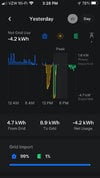Can you tell by examining the system behavior whether with that combination of options the system imposes the restriction that Net Export < PV Production? As a running total, not as an instantaneous constraint.
I.e. With the battery charged both from solar and from the grid, that the grid charged portion of the battery is only used for house loads (load time shifting), and any amount that gets exported to the grid comes from the solar charged portion of the battery (production time shifting)?
Cheers, Wayne
You raise an interesting issue.
(First, a clarification. The limitation is on Export, not Net Export. If you import a bunch and then export it all, your net export is zero. The utility will gladly let you import as much as you want, but don't want you to export what you imported from them, banking the price difference.)
It is certainly possible to export more than solar produces. One could, as an extreme, simply open the breakers to the inverters, and hence produce no solar. Grid charging would proceed, and Export everything would export. So one could conceivably export more than solar production. However, check my thinking below and see if you agree that it won't be a problem.
First, PG&E calculates my estimated solar production each month, and will limit the monthly NEM credit to that amount of export. (This calculation is explicit in the detailed monthly, so called "black&white" bill.) So, my hypothetical above would not be a problem, because PG&E would still estimate potential solar production, and allow that much export.
But back to reality, since the grid charging feature arrived around this April, my system has been doing very little grid charging, because the long, mostly sunny days charge easily to 100%. With no grid charging, all export and house consumption is from solar. So daily export can not exceed solar production, even though the solar export may be time-shifted by the PW so it happens during peak period.
Winter will be a different story, as my cloudy day production will sometimes fall short of full charging, and grid charging will make up the difference. The worst case would be zero solar production, with all charging coming from the grid. Staying with this worst case, if we assume all discharge is to the grid, each day the PW will import and export 80% (charges to 100, discharges to my backup reserve of 20%) or 10.8 kWh. In Dec, Jan and Feb, PG&E estimates my solar production will be 10.3, 9.5 and 9.8kWh respectively. So in this worst case, I would need to self-consume from the PW 1kWh or less per day, on average, to get full credit. Since my peak and partial peak hours of consumption typically amounts to ~50%, or 6.75kWh, and comes from the PW, the export limit won't be a problem in the winter either.
Things might be different for folks in different situations. Larger battery would allow more exporting. Smaller solar would allow less. I think in Calif, larger systems, i.e. 3 or more PW are not allowed to export everything anyway. So everyones milage will vary.
Does this sound right to you?
SW



